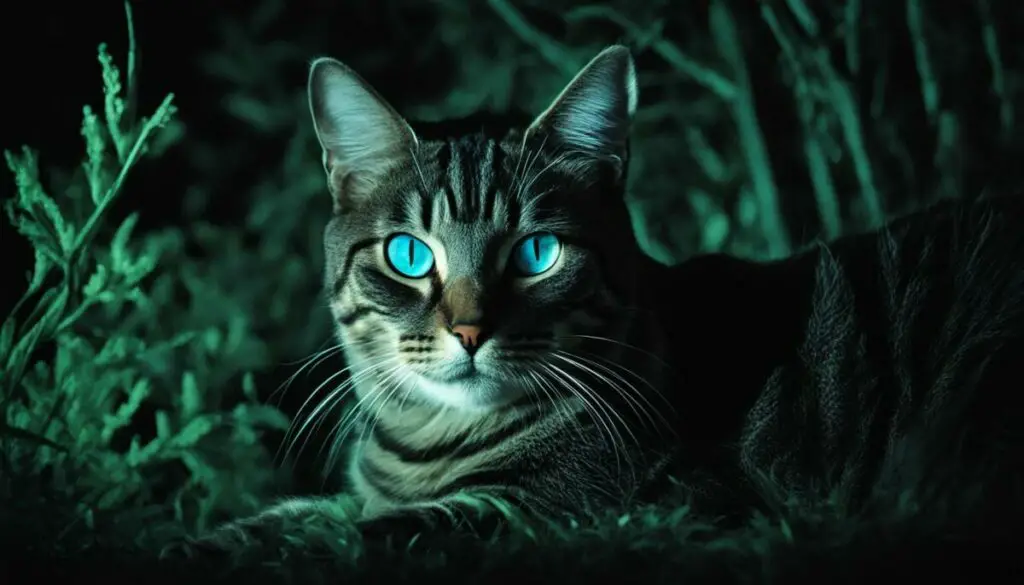Last Updated on 4 months by Francis
Have you ever wondered if cats can see infrared? While cats are known for their exceptional night vision, their visual capabilities do not include the ability to see infrared lights. Infrared light is a type of electromagnetic radiation that is invisible to both cats and humans.
Cats have superior night vision compared to humans, thanks to a higher number of rod cells in their retinas. They can see in darkness more effectively and have a wider angle of view. However, when it comes to infrared light, cats’ warm-blooded nature prevents them from perceiving it.
Infrared light is invisible to both cats and humans, but it can be felt as heat. It is a form of electromagnetic radiation that is produced when atoms absorb and release energy. Every object in the universe emits some level of infrared radiation, which is one of the three ways heat is transferred from one object to another.
While cats cannot see infrared lights, they do possess a remarkable ability to sense heat using their heat receptors. This allows them to find warm spots and navigate their surroundings with precision.
Contents
Key Takeaways:
- Cats cannot see infrared lights like humans.
- Infrared light is a type of electromagnetic radiation that is invisible to both cats and humans.
- Cats can sense heat using their heat receptors, which allows them to find warm spots.
- Cats have superior night vision and a wider angle of view compared to humans.
- Infrared light is a form of electromagnetic radiation that is produced when atoms absorb and release energy.
What Is Infrared Light?

Infrared light is a fascinating form of electromagnetic radiation that falls within the infrared spectrum. Produced when atoms absorb and release energy, it is invisible to both cats and humans but can be felt as heat. In fact, every object in the universe emits some level of infrared radiation. This invisible light plays a crucial role in the transfer of heat between objects, making it one of the three primary methods of heat transfer.
Just like visible light, infrared light behaves as a wave, but with a longer wavelength. While humans have the remarkable ability to perceive a broad spectrum of colors, infrared light is beyond our range of sight. Instead, it serves as a vital tool in various fields, such as thermal imaging, medicine, and even electronics.
In the vast universe, infrared light is ubiquitous, originating from celestial bodies, living organisms, and even inanimate objects. Its presence can be detected and utilized for a multitude of purposes, ranging from analyzing distant galaxies to studying the thermal properties of everyday items.
“Infrared light, although invisible, permeates our surroundings, shaping our understanding of the world in ways we may not fully comprehend.”
Whether we make use of it to capture stunning thermal images or harness its heating capabilities in daily life, infrared light silently plays a vital role in our existence.
| Key Points |
|---|
| Infrared light is part of the electromagnetic spectrum. |
| It is produced when atoms absorb and release energy. |
| Invisible to the human eye, infrared light can be felt as heat. |
| This form of radiation is present throughout the universe. |
| Infrared light is used in various industries, including medicine and electronics. |
| Every object emits some level of infrared radiation. |
| It plays a crucial role in heat transfer. |
Why Cats Can’t See Infrared Lights

Despite their impressive visual abilities, cats, like humans, are unable to see infrared lights. This is due to the fact that cats are warm-blooded mammals, just like us. Unlike cold-blooded animals such as certain snakes, who possess the ability to detect infrared radiation, cats lack the necessary visual adaptations to perceive this invisible light.
If cats were able to see infrared light, their own body heat would interfere with their vision, resulting in a world where temperature variations took precedence over colors. As warm-blooded mammals, cats rely on their other sensory mechanisms to navigate and hunt effectively.
However, while cats may not be able to visually detect infrared light, their bodies are equipped with heat receptors that allow them to sense and locate sources of warmth. These heat receptors play a crucial role in helping cats find comfortable spaces or cozy spots to curl up.
While cats may not possess the ability to see infrared lights, they compensate with other incredible adaptations, such as their exceptional night vision and acute hearing, to thrive in their environments.
How Do Cats See?

Cats have unique visual capabilities that contribute to their exceptional hunting skills. Let’s explore how cats see and the differences between their vision and that of humans.
Night Vision: Cats have a remarkable ability to see in the dark, thanks to their high number of rod cells in the retina. These specialized cells are extremely sensitive to light and enable cats to navigate and hunt effectively at night.
Color Vision: While cats do not see colors in the same way humans do, they can distinguish between certain shades. Cats have fewer cone cells in their eyes, which are responsible for color perception. As a result, their color vision is more limited compared to humans.
Nearsightedness: Cats are generally more nearsighted than humans, meaning they have clearer vision for objects that are close to them. However, their distance vision may not be as sharp.
Peripheral Vision: Cats have a broader periphery vision than humans, allowing them to detect movements and objects at the edges of their visual field. This wide field of view helps cats be aware of their surroundings and potential prey.
“Cats’ superior night vision and periphery vision make them skilled hunters, able to navigate in low-light environments and react quickly to any movement.”
To understand how cats see the world, it’s important to consider their unique adaptations for hunting and survival. While they may not see infrared lights like some other animals, cats’ exceptional low-light vision capabilities make them successful predators.
Can You Treat Cats With Red Light Therapy?

Cats can benefit from the healing power of red light therapy. This natural and non-invasive therapeutic technique has shown positive results in treating various conditions in cats, including:
- Joint pain
- Wounds
- Soft-tissue injuries
- Arthritis
Red light therapy works by exposing cats to specific wavelengths of red and low-level infrared light. These wavelengths are known to penetrate deeply into the tissues and cells, helping to boost their energy levels and promote the healing process.
This revolutionary therapy can be a game-changer for cats suffering from pain, inflammation, and other ailments. Its non-invasive nature means it can be easily integrated into their routine without causing any discomfort. Red light therapy has gained popularity in the field of veterinary medicine, and many cat owners have witnessed the remarkable benefits it offers.
It’s important to note that red light therapy should only be administered under the guidance of a trained veterinarian. They will determine the appropriate duration and frequency of the treatment based on the specific condition and needs of your cat.
Red light therapy in cats has shown promising results, providing relief from pain and supporting the healing process. The gentle and non-invasive nature of this therapy makes it an excellent option for treating cats with various conditions. Consult with your veterinarian to explore if red light therapy is suitable for your feline companion.
How Does Red Light Therapy Work on Cats?

Red light therapy is an effective treatment for cats that involves exposing them to near-infrared and low levels of red light wavelengths. These light wavelengths penetrate deeper tissues, including ligaments and muscles, to stimulate the body’s natural healing process.
During the therapy session, the near-infrared and red light wavelengths are absorbed by cells in the body. This absorption triggers a series of biochemical reactions that promote cellular regeneration and tissue repair. The light energy boosts energy levels in cells, which can accelerate the healing process in cats.
Red light therapy is a safe and painless treatment option for cats, as it does not harm their skin or cause discomfort. It is completely non-invasive, allowing cats to experience the benefits of the therapy without any adverse effects.
Benefits of Red Light Therapy for Cats
- Accelerates wound healing
- Reduces inflammation
- Alleviates joint pain and stiffness
- Improves circulation
- Enhances muscle recovery
- Eases arthritis symptoms
Cats can greatly benefit from the healing properties of red light therapy. Whether they are recovering from an injury, dealing with arthritis, or experiencing muscle discomfort, red light therapy can provide relief and promote a faster healing process.
“Red light therapy has been a game-changer for my cat. She was struggling with joint pain, but after a few sessions of red light therapy, she’s been much more active and comfortable.” – Cat owner testimonial
Additionally, red light therapy is a non-invasive alternative to medications or invasive treatments. It can be easily administered at home or through veterinary clinics, making it convenient for pet owners and reducing stress for cats.
| Condition | Benefits of Red Light Therapy |
|---|---|
| Joint pain and stiffness | Reduces inflammation and improves mobility |
| Wound healing | Accelerates tissue regeneration and reduces the risk of infection |
| Arthritis | Relieves pain and stiffness in joints |
| Muscle recovery | Speeds up muscle healing and reduces soreness |
Red light therapy provides a holistic approach to cat care, enabling effective healing and improved well-being. Its non-invasive nature and proven benefits make it a valuable treatment option for a variety of conditions in cats.
What Animals Can See Infrared Lights?

While cats cannot see infrared lights, certain animals possess the remarkable ability to detect or see infrared light. These animals have specialized adaptations that enable them to sense or perceive infrared radiation. Let’s explore some of these fascinating creatures:
- Snakes: Snakes are well-known for their infrared vision. They have specialized heat-sensing organs called pit organs, located around their mouths, which allow them to detect the infrared radiation emitted by warm-blooded prey.
- Bullfrogs: Bullfrogs have been found to possess infrared-sensing capabilities. Their eyes contain rod cells that are sensitive to long-wavelength light, including infrared radiation. This enables them to locate prey, such as insects, even in low-light conditions.
- Bloodsucking Insects: Certain bloodsucking insects, like mosquitoes, can detect the infrared radiation emitted by warm-blooded hosts. This helps them locate their next source of blood meal.
- Fish: Some fish, particularly those living in deep-sea environments, possess a unique form of vision called parietal-eye sensitivity. This sensitivity allows them to detect infrared light and helps them navigate in their dimly lit habitats.
These animals have evolved fascinating adaptations that allow them to see or sense infrared light, granting them a unique advantage in their respective environments.
The Incredible Heat-Sensing Pit Organs of Snakes
The ability of snakes to see infrared light is truly remarkable. Their heat-sensing pit organs, also known as loreal pits, are found on either side of their heads. These pits detect the slightest temperature differences in their surroundings, enabling them to detect warm-blooded prey, even in complete darkness.
Snakes, such as the pit vipers, possess highly sensitive nerve fibers within these pit organs. When an object emits thermal radiation, the heat energy is absorbed by these nerve fibers, generating electrical signals that are interpreted by the snake’s brain as an infrared image. This fascinating adaptation gives snakes a unique advantage in their hunting strategies.
| Animal | Special Adaptations for Infrared Vision |
|---|---|
| Snakes | Heat-sensing pit organs allow them to detect infrared radiation emitted by warm-blooded prey. |
| Bullfrogs | Rod cells in their eyes enable them to detect long-wavelength light, including infrared radiation. |
| Bloodsucking Insects | Detect the infrared radiation emitted by warm-blooded hosts, aiding in locating their next blood meal. |
| Fish | Utilize parietal-eye sensitivity to detect and navigate using infrared light in deep-sea environments. |
Cats and Infrared Light Detection
There is an ongoing debate and controversy surrounding the ability of cats to see infrared light. Some studies suggest that cats have the ability to detect infrared radiation, while others have failed to replicate these findings. While cats may have the ability to sense heat given off by objects, their eyes are not well-adapted to focus on infrared light and form clear images.
Although cats cannot see infrared light, their keen sense of smell and exceptional vision capabilities make them highly skilled hunters. They have superior night vision due to a higher number of rod cells in their retinas, allowing them to navigate and hunt effectively in low-light conditions.
While the controversy continues, it is clear that cats have remarkable sensory abilities that enable them to thrive in their environment, even without the ability to see infrared light.
Feline Vision Capabilities

Cats possess remarkable vision capabilities, particularly in low light conditions. This is due to their abundance of rod cells in the retina, which enables them to see effectively in the dark. While humans rely on the presence of light to perceive their surroundings, cats’ eyes have evolved to function optimally in low-light environments.
However, there are distinct differences between feline and human vision. One notable distinction is in color perception. Cats have a narrower range of colors they can distinguish compared to humans. Their color vision is more limited, leaning towards shades of blue and green. In contrast, humans possess a wider spectrum of color perception, allowing for a more vivid and detailed visual experience.
Another significant difference lies in cats’ night vision abilities. With their superior adaptation to dimly lit environments, cats excel at hunting and navigating during nighttime hours. Their highly sensitive rod cells enable them to detect even the faintest movements and perceive depth more accurately in the dark. This gives them a unique advantage in their role as nocturnal predators.
In summary, cats’ feline vision capabilities showcase their ability to thrive in low-light conditions, facilitating their role as exceptional hunters. While their color perception may differ from humans, their specialized adaptation for night vision ensures they can navigate and prey upon their targets with great efficiency.
Comparing Cats’ Infrared Vision to Other Animals
When it comes to infrared vision, cats have certain advantages over other animals. While dogs have the ability to detect and track infrared radiation emitted from warm objects, their vision is not as well-adapted to low light as cats. Cats, on the other hand, have exceptional low-light vision capabilities, making them skilled hunters in the dark.
Reptiles, such as snakes, have a different approach to infrared vision. They can see in the infrared spectrum, which allows them to locate prey by detecting their body heat. This unique ability gives reptiles an advantage in hunting and survival.
Cats, dogs, and reptiles all have their own unique adaptations when it comes to vision and infrared perception. Here’s a comparison table showcasing their key differences:
| Cats | Dogs | Reptiles | |
|---|---|---|---|
| Low-Light Vision | Exceptional | Good | Good |
| Infrared Perception | No | Yes | Yes |
| Ability to Track Prey | Yes | Yes | Yes |
As seen in the table, cats have a unique advantage over other animals due to their exceptional low-light vision capabilities. While dogs and reptiles can perceive infrared radiation, they do not possess the same level of low-light vision as cats.
Understanding Infrared Light
Infrared light, with its longer wavelength, is an invisible form of electromagnetic radiation that lies beyond the range of human vision. Despite being invisible, it has various applications in different fields due to its unique properties. Let’s explore the fascinating world of infrared radiation and its practical uses.
The Wavelength and Spectrum
Infrared light has wavelengths longer than those of visible light. While human eyes can perceive light with wavelengths ranging from approximately 400 to 700 nanometers, infrared light extends beyond this range, starting at around 700 nanometers and stretching up to a few millimeters.
For convenience, infrared radiation can be divided into three categories based on wavelength:
- Near-infrared: From 700 to 1400 nanometers
- Mid-infrared: From 1400 to 3000 nanometers
- Far-infrared: From 3000 nanometers to a few millimeters
Each category possesses distinctive properties and finds specific applications in various fields.
Infrared Radiation Applications
The unique properties of infrared radiation make it valuable in a variety of applications:
- Thermal Imaging: Infrared cameras, also known as thermal cameras, capture the heat signature of objects and convert it into visible images. This enables us to detect temperature variations and identify heat sources, which finds applications in fields such as surveillance, building inspections, and medical diagnostics.
- Medicine: Infrared radiation is widely used in medical applications. For example, in photobiomodulation therapy, also known as low-level laser therapy, infrared light is used to promote tissue healing and reduce pain. Infrared saunas, which emit infrared radiation to heat the body, are also popular for relaxation and detoxification.
- Electronics: Infrared communication technology, such as infrared remote controls, allows us to wirelessly control devices such as televisions and air conditioners. Infrared sensors are also utilized in devices like proximity sensors, motion detectors, and ambient light sensors.
- Astronomy: Infrared telescopes are employed to study celestial objects that emit infrared radiation, providing valuable insights into the composition, temperature, and movements of stars, planets, and galaxies.
Infrared Light: More than meets the Eye
“Infrared light, with its longer wavelengths, illuminates hidden worlds and revolutionizes our understanding of the universe.”
Applications of Infrared Radiation
| Field | Application |
|---|---|
| Surveillance | Thermal imaging cameras for detecting heat signatures |
| Building Inspections | Identifying insulation issues, water leaks, and electrical faults |
| Medical | Promoting tissue healing, reducing pain, and relaxation in infrared saunas |
| Electronics | Wireless communication with infrared remote controls and sensors for various applications |
| Astronomy | Studying celestial objects and their characteristics |
As we delve deeper into the world of infrared light, we discover its diverse, innovative applications that enhance our understanding and improve our lives.
Conclusion
In conclusion, cats may not have the ability to see infrared lights, but they possess extraordinary low-light vision capabilities. Their eyes are highly adapted to see in the dark, allowing them to become skilled nighttime hunters. While there is ongoing debate about whether cats can detect infrared radiation, infrared technology can still play a valuable role in cat care.
Despite not perceiving infrared lights, infrared technology can be utilized in various ways to benefit cats. For instance, it can be used to detect injuries by analyzing thermal patterns and provide warmth through infrared heating pads or beds. By harnessing the power of infrared light, cat owners can enhance their pets’ overall well-being and comfort.
In summary, the absence of infrared vision in cats does not diminish their remarkable visual abilities. Their exceptional low-light vision, coupled with their innate hunting instincts, makes them fascinating and resourceful creatures. Although they may not see the world in the same way as humans, cats continue to captivate us with their unique vision and their ability to thrive in the darkness.
FAQ
Can cats see infrared lights?
No, cats cannot see infrared lights like humans can. They do not have the ability to perceive infrared light due to their warm-blooded nature.
What is infrared light?
Infrared light is a type of electromagnetic radiation that is invisible to both cats and humans. It is a form of heat that is emitted by all objects in the universe.
Why can’t cats see infrared lights?
Cats, like humans, cannot see infrared lights because they are warm-blooded mammals. If they could see infrared light, their vision would be overwhelmed by the heat emitted from their own bodies.
How do cats see?
Cats have superior night vision due to a high number of rod cells in their retinas. They have limited color perception compared to humans but have a wider field of peripheral vision.
Can you treat cats with red light therapy?
Yes, red light therapy can be used to treat various conditions in cats. It is a safe and non-invasive therapeutic technique that can promote healing.
How does red light therapy work on cats?
Red light therapy exposes cats to red and low levels of infrared light, which stimulates the healing process in cells. It can be used to treat joint pain, wounds, and other injuries.
What animals can see infrared lights?
Certain animals like snakes, bullfrogs, bloodsucking insects, and fish have the ability to detect or see infrared light. They have adaptations that allow them to sense or perceive infrared radiation.
Do cats have the ability to see infrared light?
There is ongoing debate and controversy over whether cats can see infrared light. Some studies suggest they can detect infrared radiation, while others have not been able to replicate these findings.
What are the feline vision capabilities?
Cats have exceptional low-light vision capabilities due to a higher number of rod cells in their retinas. They are more nearsighted and have limited color perception, but they excel at hunting in the dark.
How does cats’ infrared vision compare to other animals?
Cats do not have the same level of infrared vision as certain animals like dogs and reptiles. While dogs can detect and track infrared radiation, cats have a unique advantage in low-light vision.
What is infrared light and how is it used?
Infrared light has a longer wavelength than visible light and is used in various applications such as thermal cameras, medicine, and electronics. It can be divided into near-infrared, mid-infrared, and far-infrared.
Conclusion
Cats cannot see infrared lights, but they have exceptional night vision capabilities. Infrared technology can still be used in various ways to provide care for cats, such as detecting injuries and providing warmth.








